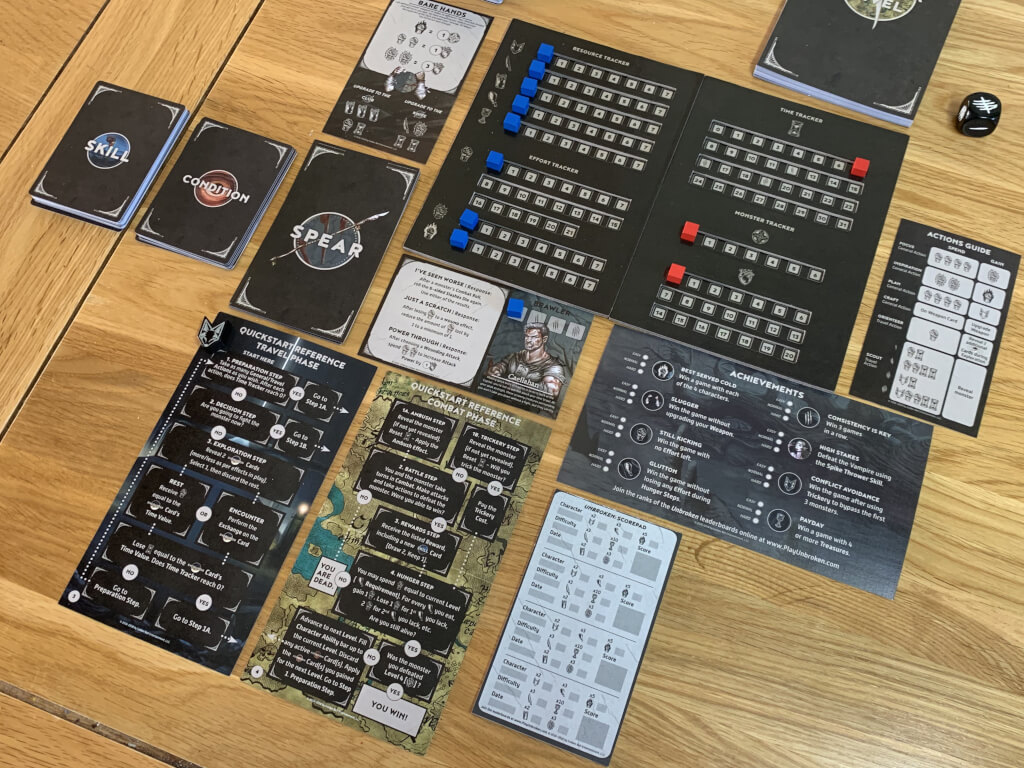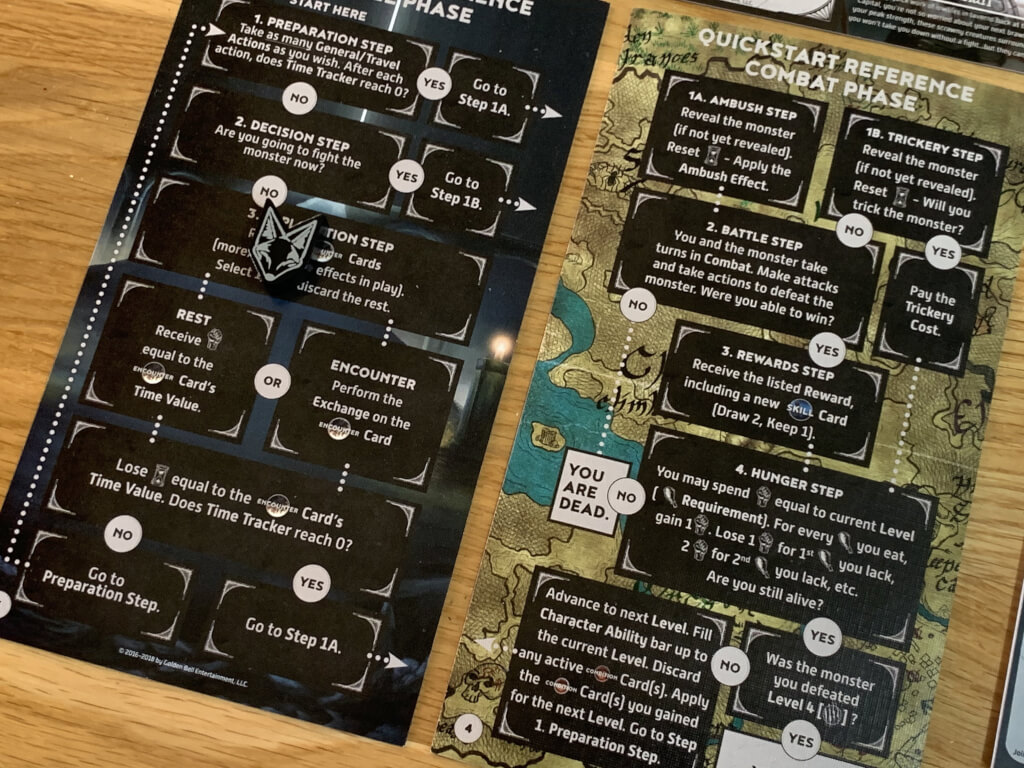Whist most of the hype surrounding the Kickstarter for Unbroken has been for the wrong reasons — due to supply issues and some very suspect comms from the publisher — the game is now finally being sent out to backers.
Whilst Unbroken might well be the most backed single-player board game ever (my claim, not at all backed by the publisher), this could be a very difficult review to write. After all, I play the solo modes in almost all board games that have them, yet many of them feel tacked on, or very much like secondary features alongside a traditional multiplayer game. In Unbroken, we have a game that is only for the solo player, and as such it is incredibly focussed.
Each game begins with the player setting up a number of boards, as well as a few decks of cards. The focal point is the chosen character (drawn from a deck of four) and the two inset boards that track resources for both the player and the current enemy. A deck of encounters and one for monsters will be placed nearby, as will one for weapons, one for conditions and one for skills.

The preamble for Unbroken suggests that the player takes the role of a failed adventurer who has been left for dead by a band of enemies. Having patched themselves up, the player character will their ascent to the surface — facing off against four enemies of increasing toughness as they go. Unbroken plays in about twenty to thirty minutes and because of its small box, it’s very suitable for packing in travel bags or suitcases, although I would say that it still has quite a large footprint when setup.
The game begins with the player having no weapons or resources and just thirteen “small” effort. Effort comes in small, medium and large and represents both the ability to do things (like explore or attack) and the players health, meaning that if you run out of effort, you will perish. At the beginning of the game, a time tracker will be set to seven, giving the player the opportunity to prepare for the first enemy, which will not yet be revealed.
The game then begins with the player following two conjoined game flow charts that track the sequence of each round. In short, the player can take as many preparation or travel actions as they like, but some of these will burn time, and if the timer ever reaches zero, the monster will ambush you. One prudent action is to Scout — which allows the player to reveal the next monster by rolling a dice and choosing the matching creature from the deck of six that correspond to the current level.

Monsters are highly varied, and one thing that surprised me about Unbroken was in the amount of difference between them. Fighting an imp, for example, might introduce the need to add a Cunning (which are hard to get) to each attack, even though the imp itself has little health when hit. A Bogart Warlord, on the other hand, has both armour and a lot of health, so to defeat him it may be prudent to focus on poison or armour piercing attacks — if you have them.
Before you do actually get into combat, you may also want to do some exploring (in addition to preparing or travelling.) To explore, you’ll flip over two cards from the encounter deck and then choose one of them to activate (it’s also possible to spend effort to draw four cards, giving you a better spread.) Most encounter cards offer a way to exchange one resource for another — time for effort, small effort for medium or large effort, and so on.
The most useful encounter cards are those that introduce resources that can really help in the current encounter. Wood and metal might enable you to upgrade your Bare Hands weapon into a knife, whilst beyond that, a spear or sword might become available. Skills are extremely valuable, but often need advanced resources like Cunning to activate, so again, any encounters that generate these resources are great. The downside of each encounter is that it will take at least one time, but sometimes a lot more than that — and being ambushed is always bad.

So assuming that you do some preparation and some travel, then you explore a few times and maybe build up your resources (having focussed them in a certain way because you scouted) and then you’re facing down the monster in battle (having not been ambushed!) At this point, on easy or medium difficulty the player will strike first, and the objective is almost always to kill the enemy in one or two blows at most — more than this and you’ll be in real trouble.
Assuming the monster survives the first attack, the player will roll a dice and depending on the outcome, the player will take a wound, lose resources, gain a condition or something else that is bad. In some cases, the monster might miss, but that’s fairly rare and only really applies to the level one (and sometimes level two) monsters. If the monster is defeated, then the player will receive a number of rewards — usually food, effort, one or two special resources and then a new skill (from a choice of two drawn from the deck.
The player also has the option to trick the monster and effectively sneak past it, and again to do so you’ll need to spend resources to do so. Hyena’s can be distracted with food, imps with trinkets and so on and so forth. The only downside is that in sneaking past an enemy, you won’t get the reward (nor the satisfaction) for defeating it.

The truth is that sometimes, a monster might seem undefeatable — and the option to sneak past is often based on very different resources to those that would be needed to defeat the monster in combat. This counteracts the issue that sometimes in Unbroken, you simply won’t see the cards that generate certain kinds of resources, and so you’ll be left to make do with whatever you have.
After each battle with a monster, you’ll then need to eat. The player is expected to consume one food for each level of the monster just defeated — so after the first battle, you’ll consume one, then two after the second and so on. This is harder than it may appear, simply because food isn’t a resource that you’ll often want to collect, but it is one that you must. Starvation, simply put, costs a lot of effort.
Continue this cycle of preparing, exploring and growing ever stronger for four rounds and defeat four opponents (whilst making sure to take in plenty of protein) and you’ll win Unbroken, gaining your freedom from the gloom and cruelty of the caves in the process. Run out of effort at any time as the result of combat or starvation and you’ll die, thus being forced to begin again. There’s no doubt that when played on its hardest most, Unbroken is tough, and it’s when I lose that I’m grateful that the game only takes about twenty minutes.

Unbroken is a bit of a weird one because it is so niche, but it’s also very enjoyable. It has a decent narrative flow and it feels fast and tense most of the time, whilst also being just about random enough to keep things interesting, and yet not so random that it frustrates. You may certainly see bad combinations of encounters and monsters that result in death, but because each game is short, you can just reset and begin again.
Everything about the game is produced nicely, although in my Kickstarter version I received a velvet bag that appears to have no function in the game (it’s not explained in the manual) as well as several blank cards for each deck, which I assume are there to allow players to create their own components. Again, no explanation is given as to how these should be used.
Assuming that it ever makes retail, Unbroken isn’t likely to be prohibitively expensive. It’s nice looking and well made, but it’s a small enough game that I’d expect it to be under £30. If that’s true, you’d only need to play it five or ten times to get your monies worth, and each of those games would likely be enjoyable and varied.

Go beyond ten games (or so) and you’ll start to see the same encounter cards and certainly more and more of the same monsters (there are 24 in total and you’ll see four per game) which can result in a boredom factor. Despite this minor issue, I’d call Unbroken a success because I still enjoy playing it when I am in the mood. It’s nice to have a solo game that doesn’t come with the elaborate setup of a converted multiplayer game, and it’s also a good game to lend to friends who might never have played a solo game.
You can find more information about Unbroken on Altema Games’ website.
Love board games? Check out our list of the top board games we’ve reviewed.
